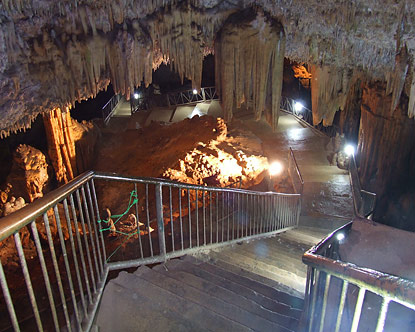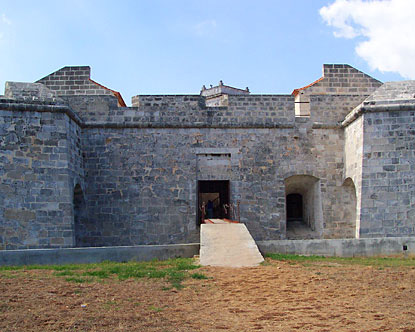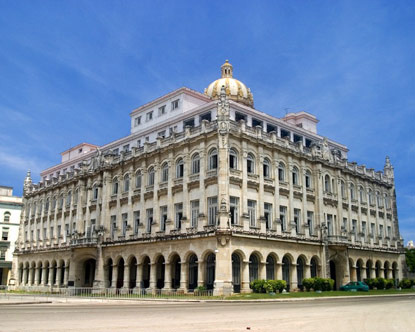 |
|
| |
| Cuevas de Bellamar |
| One thing is for sure when it comes to the Cuevas de Bellamar. They will both impress and confound you all at once. Hidden underground, away from the tropical sun, a magical world exists here, where mesmerizing crystalline domes and formations come in an astonishing range of shapes and sizes. The magical world also includes underground rivers and ponds, and indigenous pictographs. They have believed to have formed 300,000 years ago. The cave system found here extends nearly two miles. This magical world wasn't discovered until 1861. Legend has it, that a slave's tool was lost in a hole in the ground, thus leading to excavations. |
 |
|
| The Cuevas de Bellamar is 25 miles southwest from Varadero, and 60 miles east of Havana. You can easily arrange a tour of the Cuevas de Bellamar at one of the resorts that line the Varadero beach. A good majority of the Havana hotels and local tour agencies can help you find a way to get there. The Cuevas de Bellamar is open from 9 a.m. - 6 p.m. daily. |
| |
| Castillo de la Real Fuerza |
| During the early 1400’s Cuba was the stepping stone into the “New World.” As the years continued Europe and Spain wanted to conquer Cuba. Locals became tired of having to live in what seemed like constant threat. So they built the Castillo de la Real Fuerza. The Castillo de la Real Fuerza was a modest structure offering little in any way of true protection, which would come back to haunt the city. Word was spread that Cuba was ripe for attack, so the Castillo de la Real Fuerza was rebuilt. It wasn't until the year 1582 that the Castillo de la Real Fuerza was finished, but that is early enough to make it the oldest surviving fort in all the Americas. Some of the Spanish colonialists thought the castle was still pretty inadequate, but with other impressive structures being built. |
 |
Built in a square pattern with thick walls, the Castillo de la Real Fuerza was certainly solid. However, it's location on the island was too far inland, and in the end it was deemed too small. For some time, people thought to destroy it, but it survives to this day, helping to give Old Havana a big part of its identity. |
|
| Of particular interest the Castillo de la Real Fuerza west tower is a popular discussion. It is topped by a weather vane, known as La Giraldilla. The bronze statue of a woman has become a symbol of Havana. Supposedly, it is meant to depict the wife of Spanish Conquistador Hernando De Soto. When De Soto sailed from Cuba to Florida in 1539, his trip saw him gone for quite some time. It is said that de Soto's wife, Doña Isabel de Bobadilla, died of a broken heart. La Giraldilla awaits her lover atop the Castle of the Royal Force. La Giraldilla that adorns the castle is not the actual one. That statue, which dates back to 1634, can be found at the Museo de la Ciudad. |
| |
| The Museo de la Revolucion |
|
The Havana museums definitely have some interesting choices among them, and the Museo de la Revolucion is the most intriguing. The Museo de la Revolucion took on its new role after Fidel Castro managed to oust the then President, Fulgencio Batista. This is part of what makes the museum's building so interesting. Once the home to the fallen leader, it would become none other than a museum to pay homage to the revolutionary party that was responsible for removing him.
|
| The Museo de la Revolucion was finished in 1920. Carlos Maruri, a Cuban architect, and Paul Belau, a Belgian architect are responsible for it’s the architectural design. Interestingly enough, Tiffany & Company of New York, are responsible for much of the Palace's decor. Definitely resembling a palace found in Europe. The Museo de la Revolucion has architectural elements of French, Spanish and German influence. |
 |
|
| Behind The Museo de la Revolucion lies one of the more curious exhibits here. Housed in a glass enclosure is none other than the Granma. Revolution-aiding tanks and vehicles are also strewn about, as is part of an American U2 spy plane. Inside the museum, the exhibits are dedicated to both the Cuban Revolution, and the War of Independence that was waged against Spain. |
| |
| El Malecon |
| El Malecon is basically a waterfront walkway or avenue located in Havana. No visitor to Havana should miss a stroll along this famed and charming stretch, and get a chance to catch an El Malecon beautiful sunset. You will understand why a paved, seaside avenue can be such an asset for a city. |
 |
El Malecon Havana extends over 4 miles, from the Bay of Havana to the northwestern district of Vedado. It is a major meeting point for social gatherings in the city, and the views. El Malecon de Cuba was originally conceived by U.S. authorities at the start of the 20th century. Construction of the walkway began in the early 1900’s, after the United States gained control of Cuba after the Spanish-American War. In its early years, El Malecon partly served as a public baths area. Today El Malecon is a major area for transportation, or to simply find a spot and look out to sea. |
|
| Locals and tourist often take a quick swim or fish the sea. Walking or taking a horse carriage the best way to enjoy El Malecon. Depending on when you go, walking along El Malecon can include dodging the crashing waves that sometimes pour over the seawall. Local kids like to play a game of cat and mouse with the crashing waves. The crashing waves are strongest in the Cuban winter months. And depending on your mood you just might want to allow a wave to hit you, and take you to the ground.
|




